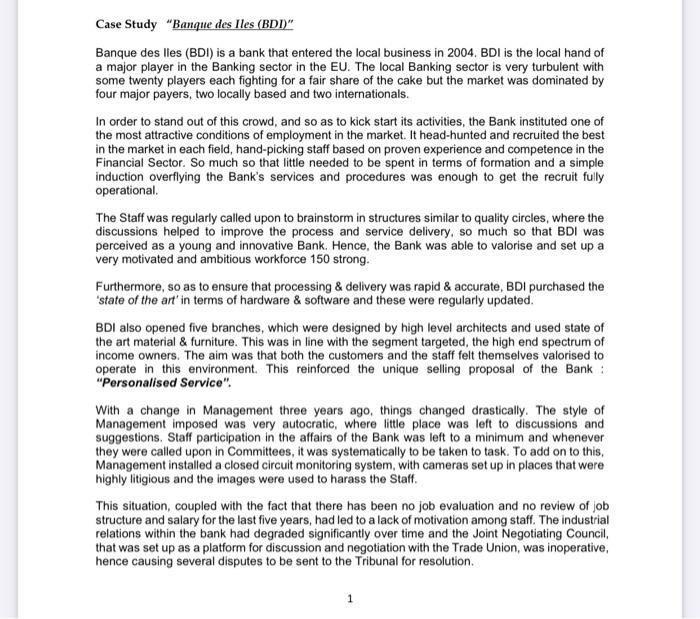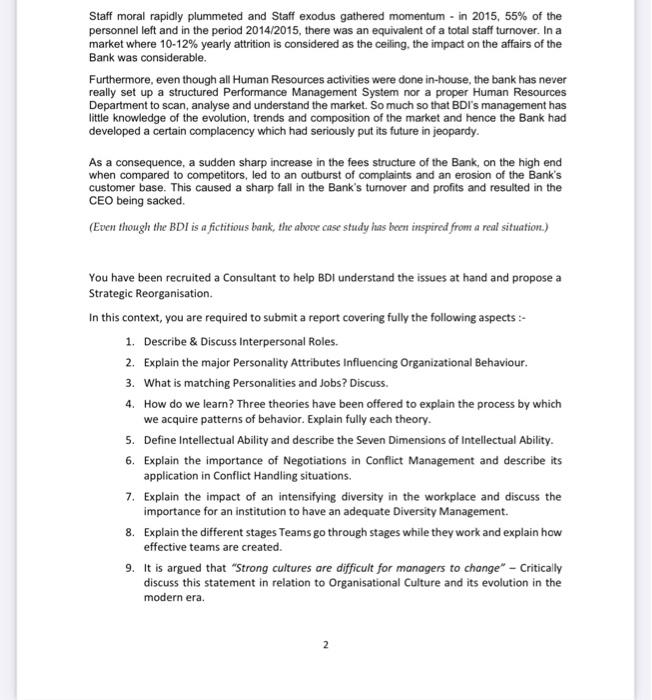Case Study "Bangue des Iles (BDI)" Banque des lles (BDI) is a bank that entered the local business in 2004. BDI is the local hand of a major player in the Banking sector in the EU. The local Banking sector is very turbulent with some twenty players each fighting for a fair share of the cake but the market was dominated by four major payers, two locally based and two internationals. In order to stand out of this crowd, and so as to kick start its activities, the Bank instituted one of the most attractive conditions of employment in the market. It head-hunted and recruited the best in the market in each field, hand-picking staff based on proven experience and competence in the Financial Sector. So much so that little needed to be spent in terms of formation and a simple induction overflying the Bank's services and procedures was enough to get the recruit fully operational The Staff was regularly called upon to brainstorm in structures similar to quality circles, where the discussions helped to improve the process and service delivery, so much so that BDI was perceived as a young and innovative Bank. Hence, the Bank was able to valorise and set up a very motivated and ambitious workforce 150 strong. Furthermore, so as to ensure that processing & delivery was rapid & accurate, BDI purchased the 'state of the art' in terms of hardware & software and these were regularly updated. BDI also opened five branches, which were designed by high level architects and used state of the art material & furniture. This was in line with the segment targeted, the high end spectrum of income owners. The aim was that both the customers and the staff felt themselves valorised to operate in this environment. This reinforced the unique selling proposal of the Bank : "Personalised Service". With a change in Management three years ago, things changed drastically. The style of Management imposed was very autocratic, where little place was left to discussions and suggestions. Staff participation in the affairs of the Bank was left to a minimum and whenever they were called upon in Committees, it was systematically to be taken to task. To add on to this, Management installed a closed circuit monitoring system, with cameras set up in places that were highly litigious and the images were used to harass the Staff This situation, coupled with the fact that there has been no job evaluation and no review of job structure and salary for the last five years, had led to a lack of motivation among staff. The industrial relations within the bank had degraded significantly over time and the Joint Negotiating Council that was set up as a platform for discussion and negotiation with the Trade Union, was inoperative, hence causing several disputes to be sent to the Tribunal for resolution. Staff moral rapidly plummeted and Staff exodus gathered momentum - in 2015, 55% of the personnel left and in the period 2014/2015, there was an equivalent of a total staff turnover. In a market where 10-12% yearly attrition is considered as the ceiling, the impact on the affairs of the Bank was considerable. Furthermore, even though all Human Resources activities were done in-house, the bank has never really set up a structured Performance Management System nor a proper Human Resources Department to scan, analyse and understand the market. So much so that BDI's management has little knowledge of the evolution, trends and composition of the market and hence the Bank had developed a certain complacency which had seriously put its future in jeopardy. As a consequence, a sudden sharp increase in the fees structure of the Bank, on the high end when compared to competitors, led to an outburst of complaints and an erosion of the Bank's customer base. This caused a sharp fall in the Bank's turnover and profits and resulted in the CEO being sacked (Even though the BDI is a fictitious bank, the above case study has been inspired from a real situation.) You have been recruited a Consultant to help BDI understand the issues at hand and propose a Strategic Reorganisation In this context, you are required to submit a report covering fully the following aspects :- 1. Describe & Discuss Interpersonal Roles. 2. Explain the major Personality Attributes Influencing Organizational Behaviour. 3. What is matching Personalities and Jobs? Discuss. 4. How do we learn? Three theories have been offered to explain the process by which we acquire patterns of behavior. Explain fully each theory. 5. Define Intellectual Ability and describe the Seven Dimensions of intellectual Ability 6. Explain the importance of Negotiations in Conflict Management and describe its application in Conflict Handling situations. 7. Explain the impact of an intensifying diversity in the workplace and discuss the importance for an institution to have an adequate Diversity Management. 8. Explain the different stages Teams go through stages while they work and explain how effective teams are created 9. It is argued that "Strong cultures are difficult for managers to change" - Critically discuss this statement in relation to Organisational Culture and its evolution in the modern era. 2








